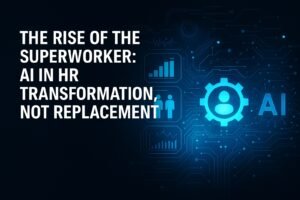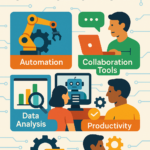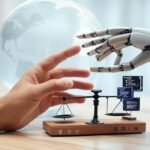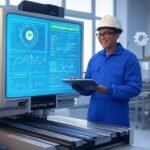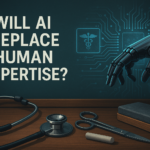Everyone’s talking about AI replacing HR. That’s not the story that matters. The real shift is about augmentation, how AI in HR transformation is helping companies create “superworkers”: people who are not only more productive, but more engaged, capable, and strategically aligned with the business. Yet despite this potential, only 4% of organizations have a clear AI strategy for HR.
That gap represents both a risk and a massive opportunity.
What Is a Superworker?
Coined by Josh Bersin in partnership with SAP SuccessFactors, the Superworker concept describes employees empowered by AI tools that amplify decision-making, creativity, and output.
Superworkers aren’t just faster, they’re smarter contributors to the mission. They leverage AI as a collaborative partner to focus on higher-value tasks while the technology handles repetitive processes. This synergy creates a more dynamic and efficient workforce.
They’re only possible when HR stops thinking about AI as automation and starts using it as a workforce multiplier.
The Four Stages of AI Maturity in HR
Bersin outlines a maturity curve companies are moving through right now:
- Assisted Intelligence – Think smart chatbots, resume sorters, and tools that handle basic scheduling or data entry.
- Augmented Intelligence – Systems that help humans make better decisions, like AI-driven interview insights and predictive analytics.
- Autonomous Agents – AI that acts on its own: dynamic scheduling, automatically generating learning paths, or internal job-matching without human intervention.
- Systemic Intelligence – AI embedded into strategy, redefining jobs, workflows, and culture from the ground up. At this stage, AI becomes foundational to how the business operates.
Only a few companies (like Delta and Mahindra) are operating at Stage 3 or 4, and they’re already seeing major business returns not just in efficiency, but in adaptability, retention, and long-term innovation.
Use Cases: From Time-Saving to Transformation
The evidence from Bersin’s research and broader HR data reveals a shift in how companies are applying AI in HR:
- Hiring & Internal Mobility: AI helps uncover hidden skills, surface internal candidates, improve hiring accuracy, and reduce time to hire.
- Learning & Development: Tools like Eightfold or SAP SuccessFactors and AI-driven automation platforms map learning to business goals and create personalized development paths.
- Performance & Feedback: AI provides real-time coaching prompts and identifies objective performance patterns.
- HR Operations: AI cuts transaction time so HR teams can focus on strategy, not paperwork.
But the biggest impact? Retention and engagement. When people feel supported, challenged, and empowered by technology rather than threatened by it, they stay longer and contribute more.
What High-Performing Companies Do Differently
The organizations leading this transformation don’t throw AI at problems randomly. They take a strategic approach:
- Upskill their teams so workers evolve with the technology
- Use AI to enhance quality, not just speed
- Focus on employee experience as a core performance driver
- Build a feedback loop, letting employees shape how AI supports them
This approach ensures AI isn’t deployed to cut corners, but to help people do better work. The result isn’t just improved efficiency, but a more engaged workforce capable of meeting future challenges.
Strategic Imperatives for HR Leaders
To harness the full potential of AI and cultivate Superworkers, HR leaders should:
- Develop a Clear AI Strategy: Align AI initiatives with organizational goals and workforce needs
- Invest in Upskilling: Provide training programs that equip employees with the skills to work alongside AI
- Foster a Culture of Innovation: Encourage experimentation and adaptability in adopting new technologies
- Ensure Ethical AI Use: Implement guidelines to address biases and maintain transparency in AI applications
The Next Chapter Starts Now
The question isn’t whether AI will change HR, it already is.
The question is whether we’ll use it to replace, or to elevate.
Companies that choose the latter are building teams ready for the future — one superworker at a time. In this new HR frontier — AI-enhanced, human-centered, and strategically aligned — organizations aren’t just surviving disruption. They’re using it to create a durable competitive edge.

